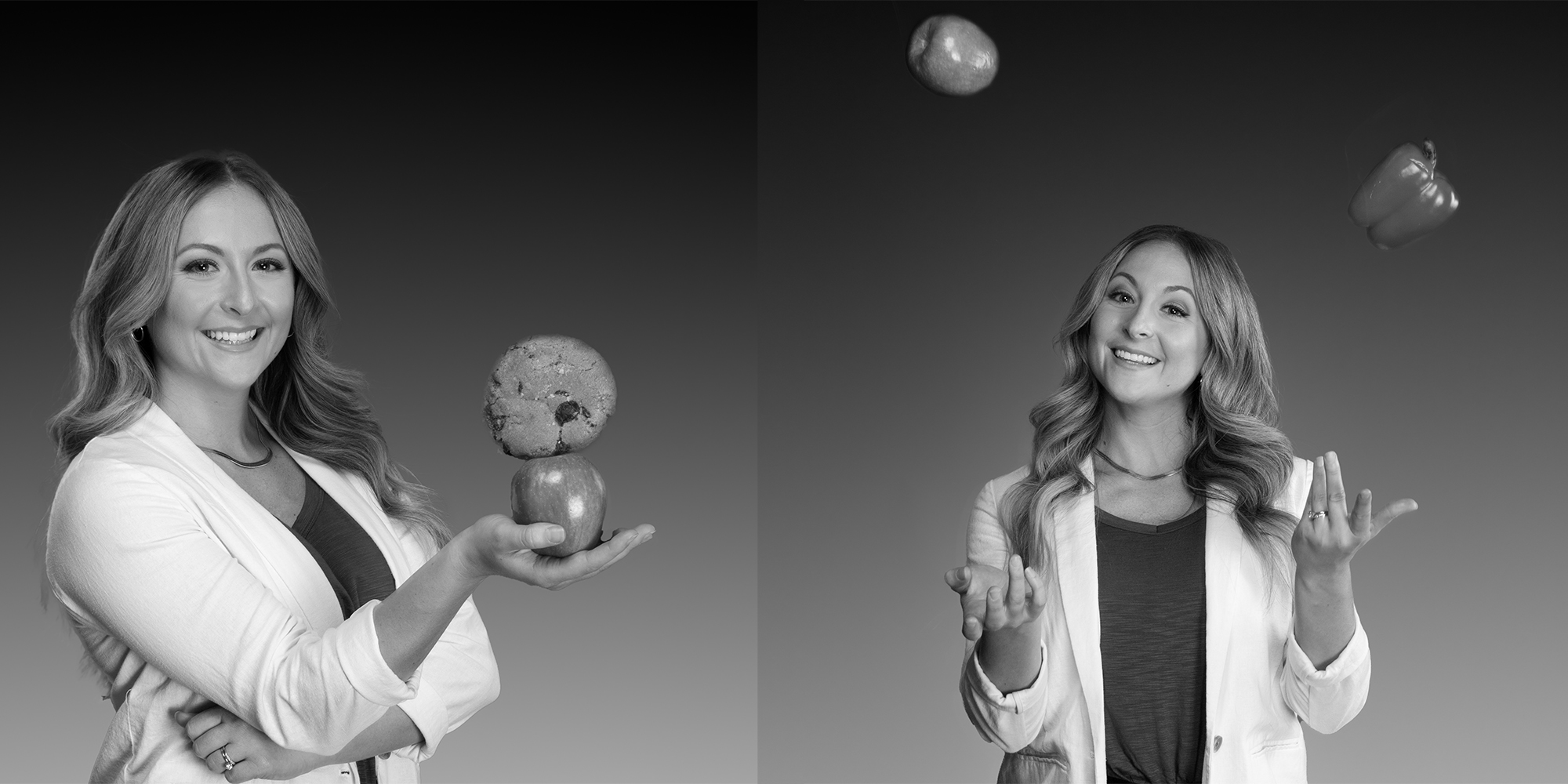Health is in the eye of the beholder, but we wanted to hear it from pros at the top of their game — what is one daily habit you practice to live a healthier life? Below, Tampa yoga instructors, nutrition experts, runners, cyclists, trainers and more share their top tips.
GRACE LOPEZ, RD, LD/N
Founder, Able Health & Wholeness | Registered Dietitian | Nutritionist
“One of the most commonly shared struggles with food is ‘overeating.’ Oftentimes, with a closer look at daily habits, I find most clients who are prone to eat beyond a comfortable satiety are usually underfueling throughout the day. To practice honoring your hunger and fullness cues, start by implementing a few intentional ‘check-ins’ throughout the day. Take 30 to 90 seconds to intentionally observe and listen to your body, evaluate level(s) of hunger or fullness, and — the key — respond accordingly! When you adequately fuel your body, you’ll likely experience fewer ‘starved to stuffed’ eating patterns and fewer energy crashes, and you’ll begin to feel more relaxed and in control around food. As you practice acknowledging hunger, you may find a need to keep snacks on hand. I recommend a snack that’s balanced with protein, heart-healthy fats and fiber. I personally love a good trail mix with a piece of fruit!”
Tell me about your background in nutrition. How did you get into the field?
From the age of 18 to 21, I found myself working in a nonprofit humanitarian setting. It was there, I was confronted with the prevalence of hunger and malnourishment. This reality sparked a passion for sustainable feeding initiatives and quickly matured into a desire to study nutrition.
I studied Dietetics at the University of Florida and completed my Dietetic Internship (a year of supervised practice) through Sarasota County Schools. There I learned the ins and outs of running a large scale feeding program and was able to bring nutrition education to the classroom, clinical and community settings.
Once I passed the Registered Dietitian exam and became licensed, I worked for a public health program called Women, Infants and Children. This program provides qualified families with supplemental nutrition assistance and education. As a dietitian and certified lactation counselor, I had the privilege of providing nutrition and lactation counsel to medically high risk families.
I’ve since transitioned into private practice which allows me to invest even more time in my clients. Able Health & Wholeness is a nutrition coaching company that empowers women to better their relationship with food and body through self-discovery, guided support and an intuitive eating approach.
How/why did you decide to share your passion with others?
Early on in my time in nonprofit work, I became acutely aware of how easy it is to neglect self-care while being focused on caring for others. I found myself burned out yet determined to prioritize a better sense of balance moving forward.
An interest in nutrition as a form of self-care became a significant part of my own personal journey from burnout to balance. Investing time in the kitchen and around the table was therapeutic for me. In a society that screams “Hurry up, do it the fast way!” I felt compelled to help others slow down and return to mindful nourishment.
Whether a busy mom, a career-focused woman, or somewhere in between, I enjoy helping my clients prioritize and nourish themselves so that they’re able to give from an overflow, instead of a nearly empty cup.
What is the biggest myth around nutrition and/or diet that you dispel when working with your clients?
A big misconception around nutrition is that it has to be “all or nothing.” Diet culture sells a narrative of rigid food rules and restrictions in the name of health. Yet, the most popular fads are unbalanced, unrealistic, and leave you feeling a sense of failure due to lack of willpower. This perpetuates the chronic diet cycle: on a diet, off a diet, repeat — disheartening to say the least!
With Able, I prefer to approach food and nutrition from a much more enjoyable and sustainable framework. You won’t find me handing out a cookie-cutter, restrictive meal plan. Instead, I guide my clients through a proven method to improve their unique relationship with food, understand evidence-based recommendations and rebuild confidence in their ability to make choices that nourish their body.
In short, there is no magic pill for health and wholeness.
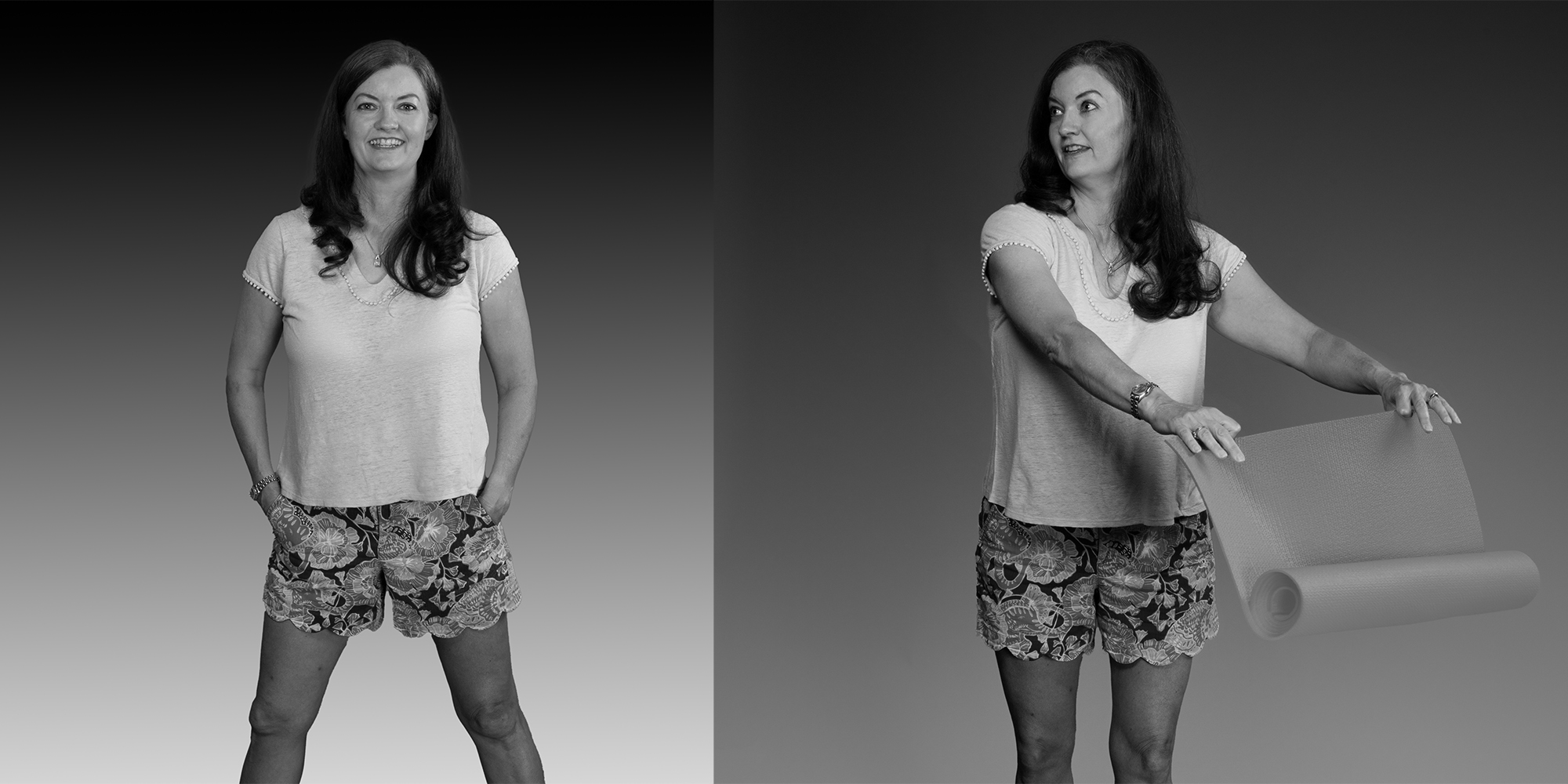
REBECCA WOOD
Owner | Yoga Instructor
Palm Yoga
“A daily healthy habit that I practice is keeping a gratitude journal. Before I go to bed, I close my eyes and take a few deep breaths to relax. Then, I pull out my gratitude journal. Each night, I write down three or more things that I am grateful for from the day. They can be big or small. What really matters is to feel a sense of gratitude in your heart. When you have a difficult day (or year), it is so nice to look through the journal and remind yourself of all of the good things in your life.”
Tell us about your background in yoga. How did you get into the field?
I took my first yoga class in Los Angeles in 1997 at a Gold’s Gym. I remember leaving that class and feeling like I was floating on air. Instantly, I fell in love with the practice. I think yoga resonated with me so strongly because I loved gymnastics as a kid. I used to do front walkovers on the stairs in my house! Within six months, I enrolled in a teacher training program and began teaching a year later. I loved teaching and connecting with people through such a life-affirming practice. At that time, in Los Angeles, yoga was just gaining mass popularity. I had the benefit of training with people that are now famous yoga teachers on a regular basis: Kofi Busia, Judith Hanson Lasater, Erich Shiffman, Leeann Carey and Richard Miller, to name a few. They have all influenced and shaped my teaching and practice of yoga.
What led you to share your passion for yoga with others and eventually open the studio?
During my time in California, I had the opportunity to join a yoga studio, Planet Yoga, as part of their management team. They had just secured an angel investor and were looking to bring on students that had business experience in various fields. It was so interesting to move from being a yoga student to being invested in yoga as a business. We had our ups and downs, but I really learned a lot from that experience. My husband and I, before we were married, used to take long walks and talk about how we wanted to own a combined yoga and jiu jitsu school in the future. Now we have Palm Yoga and Tampa Jiu Jitsu as well as Wesley Chapel MMA. The reality is much different than we had talked about during our walks, but overall it is what we planned! The two disciplines look so different, but they both bring you into moment-to-moment awareness. It is a gift to be able to turn your avocation into your vocation.
I started Palm Yoga in 2005. My husband and I moved to Tampa in late 2003 with our 6-week-old baby. I didn’t know anyone and needed a creative outlet. I had taken some classes around town, but there were no studios in Carrollwood. It was the perfect opportunity to open my own yoga studio.
What is the first thing you tell people who want to start a yoga or mindfulness journey, whether by themselves or at a studio?
The first thing that I tell people who want to start a yoga or mindfulness journey is to be realistic with your schedule. Don’t set up expectations that you will not be able to meet. Choose a class schedule or sitting schedule that you will be able to maintain long term. For yoga and mindfulness, consistency, not quantity, is key.

SHERRICE BROUSSARD ROSE, PT, DPT
Physical Therapist | Owner/Clinic Director | Dance Rehabilitation Specialist
Potentia Therapeutics
“Move more. It is important to prevent a sedentary lifestyle. … The phrase ‘sitting is the new smoking’ [reminds us] that sedentary lifestyles can lead to obesity and subsequent long-standing medical conditions such as diabetes and heart disease. Start with small movements if you are a beginner, and set new movement goals as you advance. It is never too late to move!”
Tell me a bit about your background in physical therapy. How did you get into the field?
I have always appreciated a holistic approach to health care and wellness. From my early post-college days as a genetics researcher, I learned that attaining optimal health meant understanding the building blocks of the human body. My graduate school study within the Doctor of Physical Therapy program at Emory University combined my love of clinical research with the study of human movement. As physical therapists, we define our careers as movement specialists who understand that there is a relationship between a patient’s physical, mental and emotional states and their functional abilities. I fully believe that we can rehabilitate, restore and refine our bodies and minds with this interdisciplinary approach.
What led you to share your passion for movement, dance and golf with others and eventually open the studio?
I have a true passion for movement and compassion for people, and I strive to [teach] my patients that the ability to restore their own optimal and independent movement is within their reach. This was my mission when I opened Potentia Therapeutics. As a dancer in my teenage years, we moved freely within our young bodies without the thought of possible injury that may derail our dance goals. As I began to treat dancers as a physical therapist in Atlanta, I realized that there was a scarcity of specialized treatment and injury prevention programs for pre-professional and professional dancers locally and throughout the country. After extensive training, including attaining a Dance Rehabilitation Specialist Certification at Westside Dance in New York City, I launched a dance medicine program here in Tampa for those who seek optimal performance and health. This program has been a valuable asset to our dance wellness patients at Potentia and at the Straz Center’s Patel Conservatory, where I am an adjunct faculty member in the dance department. Our team at Potentia applies the same specialized, integrative and holistic approach to every patient with diagnoses including women’s health, movement disorders, orthopaedics and sports medicine.
What is the first thing you tell people who want to learn to move their bodies in a more comfortable, healthy and/or effective way, whether they’re recovering from an injury or not?
One of the questions that I ask my patients is, “When did you feel your best self?” We begin by defining the time in their lives when they felt optimally healthy in mind, body and spirit. It is imperative to address the relationship of physical, mental and emotional states to functional movement and allow yourself to be open to establishing new goals of optimal movement regardless of your current baseline. The beauty of the human body is that we can transform ourselves to a better state. At times this transformation may require the assistance of a healthcare provider or just mastery of your own independent program. I have learned that with grit and grace, we can become our best selves and feel better in our bodies regardless of what direction we take as long as we have the wisdom to do it.
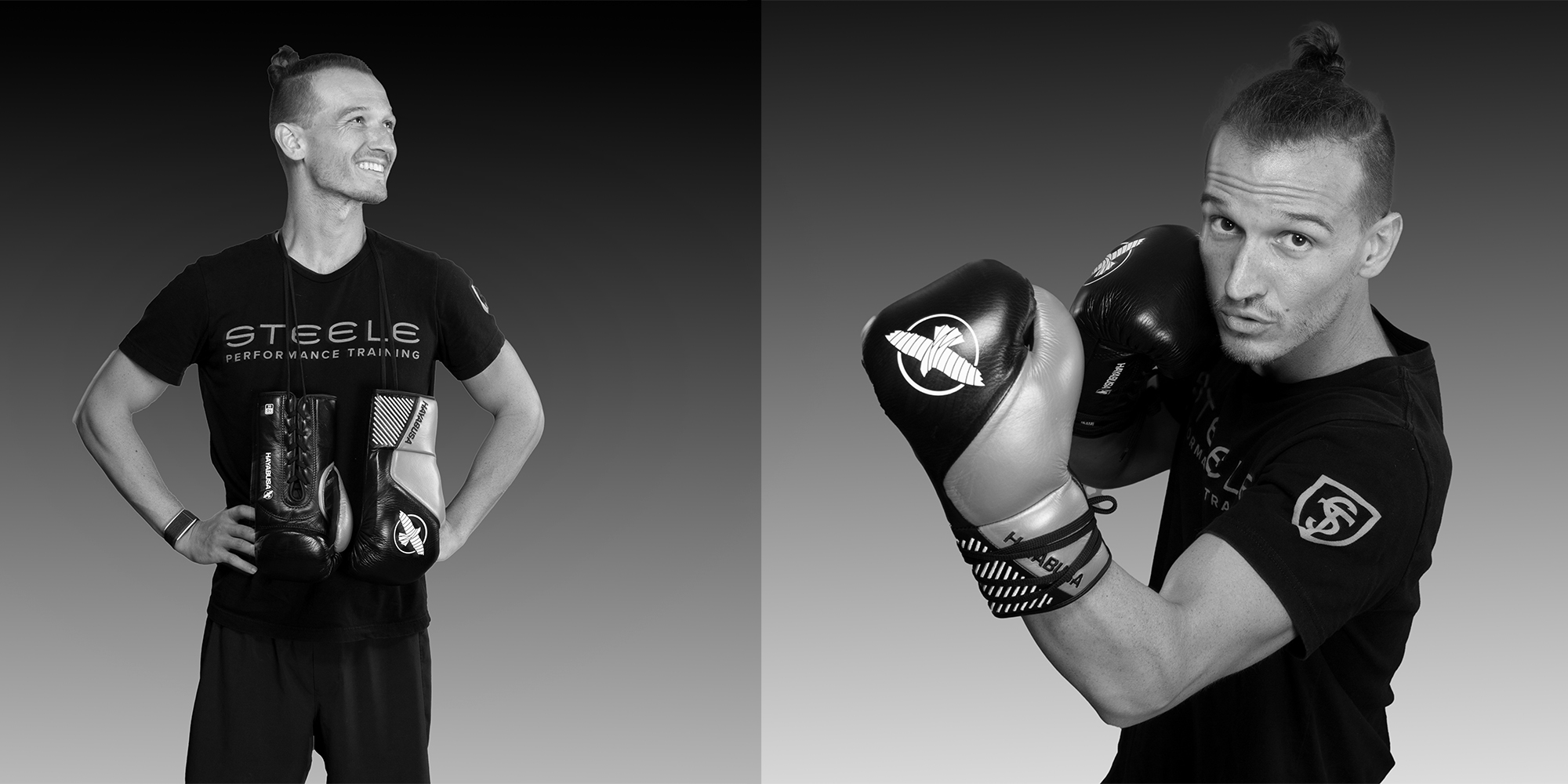
ZACH STEELE
Owner, Steele Performance Training | Personal Trainer
“Be kind to yourself. We come into these artificial spaces that we create [for fitness] and push ourselves so hard physically, mentally and emotionally. Take the time to step back, check out and really listen to your body. It will tell you what it needs. Listen to your mind. Listen to your heart. So if you take that time to really step back, be aware of yourself and be kind to yourself, you’ll find it permeating in other parts of your life. … By being kind to ourselves in the weight room or the boxing gym, we’ve found that middle ground, and maybe we’re not not afraid to call our boss and say, I need a mental health day today. Because I’ve done that so many times in so many iterations [through fitness], my confidence has grown and my self-care has really grown. To me, fitness is a place where you discover yourself.”
Tell me about your background in fitness.
It’s been a bit of a lifelong thing for me, I was always active growing up. In high school, I wrestled, I swam, I played baseball. You know, I actually went from private school, to public school to play baseball on a bigger team and all that stuff and to swim through there. I started looking at college athletics and decided that I really wanted to focus on my education and the intellectual aspect instead of the athletic aspect. That ran me all the way up to Boston and through Harvard for all of my graduate education. Following that, I actually moved back down to Tampa. I’d been working for a marketing and research firm, and all my accounts were pharmaceutical. It just kind of left a bad taste in my mouth. I felt like I wasn’t using everything I had to help people. And I felt like so many people believed in me along the way and so many people were taking care of me along the way and giving me this chance. If I wasn’t using everything I had to give back to people or change people’s lives, I really wasn’t doing it the right way.
So a couple of years ago, I sat down and just took a really hard look at my life — [my] academic background, athletic background. [I said] what are you good at? And how can you use it to help people? That really came down to, there was a big space in the fitness world. Highly educated coaches had all been kind of picked up by professional [sports] organizations and there weren’t [a lot of us] making that level of training available to the average person — to the girl who wants to lose 100 pounds who never really had somebody believe in her and sit there and hold her hand through it. Or the guy who just wants to look better in his shirt. He should have access to the same level of [highly educated] elite coaching as the guy who can pay $300 per session because he plays the Tampa Bay Bucs. So I really wanted to take this idea of an [education-focused] fitness approach and a holistic fitness approach and make sure that everybody has had access to that. The mission is still there to make sure that everybody has access to fitness, knows that they belong in the fitness space, and can actually get in here with somebody who cares about them and loves them and wants [them to achieve] their goals as much as they want [to achieve] their goals.
How did you start incorporating boxing into your training?
I was actually boxing myself just to stay in shape. It was my favorite form of cardio. I had a great coach in Brandon, who I still work with. So one day I just started doing it. I started sparring, and he put me in the ring. Next thing you knew I was pretty good at it and got sharp at it. I was out fighting in Texas right before COVID, bringing belts back and doing all this stuff. Then I kind of realized, dude, you’re 28 years old, you can really use this to help people instead of taking all these fights for yourself. It’s important to me because boxing represents more than just getting in a ring and hitting each other. For me, boxing is upward mobility. For me, boxing is representation. Boxing is something that gets in there and saves people’s lives every single day. And I see it in some of the kids that I work with. So the transition to boxing was my whole mission. My whole purpose is to help people, to save people and provide people with something that maybe they haven’t ever seen in their life — [be] somebody in a position of authority who really respects them and really cares about them. For me, boxing is the best way to get to people who may have never had anybody believe in them. They might have never had a chance, or they might have some sort of systematic failure that they’ve experienced throughout their lives. That gives us the ability to go in there and say, hey, there’s something better. There’s something about working and grinding and doing this. It’s going to give you great mental health effects. It’s going to give you great physical health effects. But if you get good at it, we can really use it to change your life.
What’s the first thing you would tell someone who starts a fitness and wellness journey with you?
I would sit down with them and let them know that I don’t take a lot of people but if you want to get a coach, find a coach that’s going to sit there with you and say, this is me and you. My phone is on 24/7. This is a journey. It’s not just an hour of my time that you purchase. This is my research time. This is my emotional time. This is me staying up worrying about you because we did a really hard leg day and I know your immune system might be compromised by that blitz to your body. It’s all of those things. And that’s the way my clients and I interact. Every day [is about] communication. How are you feeling today? How’s your mental health? So when I sit down with people, the first thing that I tell them is, this is not a workout. We’re in here to really look at ourselves holistically and to drive this forward. Because looking good is not a unilateral goal. You can’t just get in the weight room and do two or three things a day and look good. You have to take care of all the aspects of that and all of the impacts of that.
I think fitness is a place where everybody belongs. It’s not just those of us that can take off our shirts and have a six-pack. It’s not just for the girls with unbelievable bodies. It’s not that. I don’t care if it’s Sarah, the girl who I helped lose 100 pounds this year and still has maybe six more to go. Sarah belonged just as much the day she lost her first pound as the day she did she lost her hundredth. fitness should be a space where everybody can come in and everybody can learn and grow from each other. Those barriers to entry don’t exist. Fitness is no different than when we were toddlers and kids playing on the playground. All we’ve done is really apply it to our level of intellectual and physical abilities. For me, the biggest thing that I want to stress as an individual and as a coach is that fitness, especially my fitness space, is a space where I don’t care if you’ve been here or not, you belong, you’re loved, you’re cared about, and everything that you want in that space is as important to us as it is to you. And that’s how I run my company. That’s how I run Steele Performance. That’s how I run every single one of my trainings with my people. They are my heart and soul. They’re what what I drive for every day. That’s what keeps me going. These people trust you enough to sit there with you and say, hey, these are my deepest, darkest fears. These are my greatest wants, and you guys collaborate together.
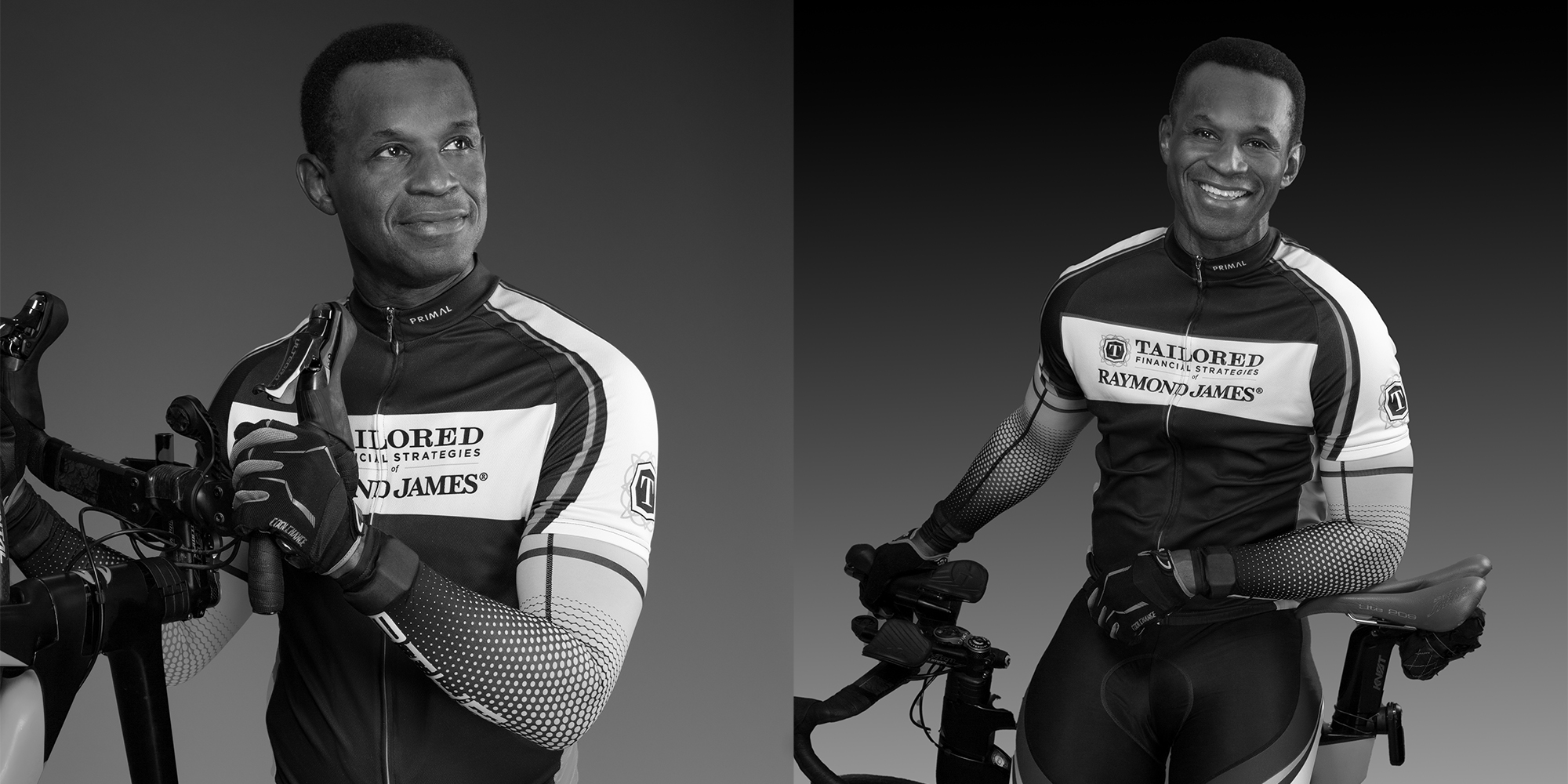
KENNIE TAYLOR
Financial Advisor, Tailored Financial Strategies of Raymond James | Cyclist
“If I were going to do one thing [to improve my health], I would focus on my sleep. It’s low cost. We all have to do it, and most of us have relatively poor sleep habits — everything from eating right before you go to sleep or staying up late to watch a movie. All of those things come at a cost. Sleep is when the brain has a chance to heal and repair. You can do all these workouts and this and that, but if in the end [of your life], you don’t know or can’t remember, what good has it done you? It’s very well documented how fast being chronically sleep deprived can make you less efficient, more irritable, all of those things. But if you can optimize sleep, I believe you’re going to be more healthy.”
How did you get into cycling?
I used to be a fitness class participant and was really into that and going to the gym and whatnot. What I noticed is, these people would come to the class or show up at the gym, year after year, and they never seemed to get more healthy, or they didn’t look more healthy. And so I said to myself, really this gym thing is not working. Along with that, my dad got diagnosed with cancer [for] the second time and I started doing a lot of research on what we can do to decrease the chance that we wind up with the list of diseases that none of us want — mostly chronic in nature. So I trained the first year after he started that treatment, and I went to the gym, I had a physical trainer, and I really got in what I hoped was going to be good physical shape to participate in the Pan-Mass Challenge, which is a cycling event that raises money for the [Dana Farber Cancer Institute] to research cancer, treatment therapies, prevention strategies and so forth. So I go up there and I’m all excited, and I’m trained, and I pick up my bike, and a guy runs into me, in a parking lot of all things, the Thursday before the event. I know I’m hurt, but I am determined that I’m gonna finish this ride because it’s the first time I’ve gone to do it. My dad’s in the midst of radiation, surgery and what have you. I rode the first day. You ride from Boston to Provincetown, essentially. Day two, I get up, and I can’t ride. I got through the first day on, I guess, will and motivation. When somebody rides by you, or you pass somebody, and they’re riding with one leg, because they’re a cancer survivor and an amputee, that really drives home the point of the event and why I was there personally.
On day two, I think I probably rode 5 or 10 miles [with] one leg basically doing all the pedaling. And I said, there’s no way I could finish. So I turn around and go back. Well, long story short, turns out that I had a cracked femur that I rode on the first day. I finally go to the doctor, because all of the women in my life were browbeating me for limping around and not seeking medical attention. I’m glad that they did, because that’s how I found out what had gone on. But after that I wasn’t able to do the workouts and the things I had done to get ready for the event. I must have gained like, 5, 10 pounds of fat in four or five months. And I went back to the research with regard to cancer prevention and healthiness. I changed, not so much my diet, but I changed strategies — things that allow me to have you sleep hygiene, when do you eat, all those types of things. And in 2018, I must have lost 10, 12 pounds, at least, and it was virtually all fat, and I worked out a lot less than I did in 2017 [when I was getting ready for the Pan-Mass Challenge]. It clicked that, going to the gym and these classes and all that stuff, that’s not the answer. It’s what we do in other facets of our life, that that really can move the needle.
Was your experience at the Pan-Mass Challenge what led you to want to share your passion for cycling with others?
I would certainly say that the personal impact of my dad going through that for the second time probably is the pivotal moment where I said to myself, I’ve got to share this information with anybody who will listen. Because I don’t know anyone who, their family or close friends haven’t been impacted in some way by health issues. To me, a lot of these things we kind of take for granted [and think] they’re going to be outcomes that are pre-determined or things that can’t be avoided. And that’s really not what the research supports. Yes, we all have a blueprint in terms of our genetics and so forth. But we can do a lot throughout our lifetime to be healthier while we’re here. As a father, I think, what could I give my kids and my wife? Well, number one, I could be here. Number two, while I’m here, I want to be able to enjoy them and not be a burden to them. So that’s how I’ve approached it. People [ask me] what are you doing? Well, I really don’t do anything. I’ve just changed my life where I integrate these strategies on a daily basis. And somebody asked me, what’s your goal of all of this? I thought about it. And I said, the 90-year-old Olympics. I can go to the airport — by myself, if I have to. I can get to the gate by myself. I can board the plane in general boarding. I can put my own carry-on in the overhead. That’s 30, 35 pounds. I can get it down by myself. I can get to the curb to catch a car service when it’s all said and done. And I said, what does that take? It takes a certain amount of memory. Where am I going? I’m going to the airport? What airline, what gate? It takes some physical strength and endurance to get to the gate, take care of my own bags. And assuming at that point in time, if I’ve got some grandchildren, grandkids run at you and they jump. You want to be able to catch them versus have them knock you over. So to me, it’s about quality of life, not necessarily how long someone lives. You know, if you live to be 90, that’s wonderful. But it’s not wonderful if you’re relatively infirm from the age of 80. That’s why I always make the distinction between healthspan, and lifespan. When you talk to people, much of the time people want to live a long time. Well, that’s part of it. But I want to have quality of life throughout whatever that time frame is.
What is the first thing you would tell people looking to get into cycling?
The first thing that you want to prepare yourself for is to ride out of your comfort zone. And to find either a group or a person who’s willing to push you with patience. Because if you always ride with people that are, you know, your level and below, you’re just not going to improve. I haven’t seen that be the case. But where I see it routinely is, you ride with people that ride faster, you ride with people that are better on the hills. So I go to San Antonio and ride the hills up there with riders who are a lot better on the hills than I am. And on the Suncoast Trail, I call them the Suncoast Speedsters, they’re very fast. And when I get dropped from the ride, and I [do] get dropped from the ride, I say, well, that was a good ride. I had to get a little bit better because they pushed me to a limit. And that limit was higher than it was three months ago or six months ago. So I kind of view it at every stage of your development, there’s always going to be the younger, the faster, the stronger rider, but at the end of the day, they better you as a cyclist. As with I think just about everything in life, you have to be willing to endure a certain amount of discomfort.
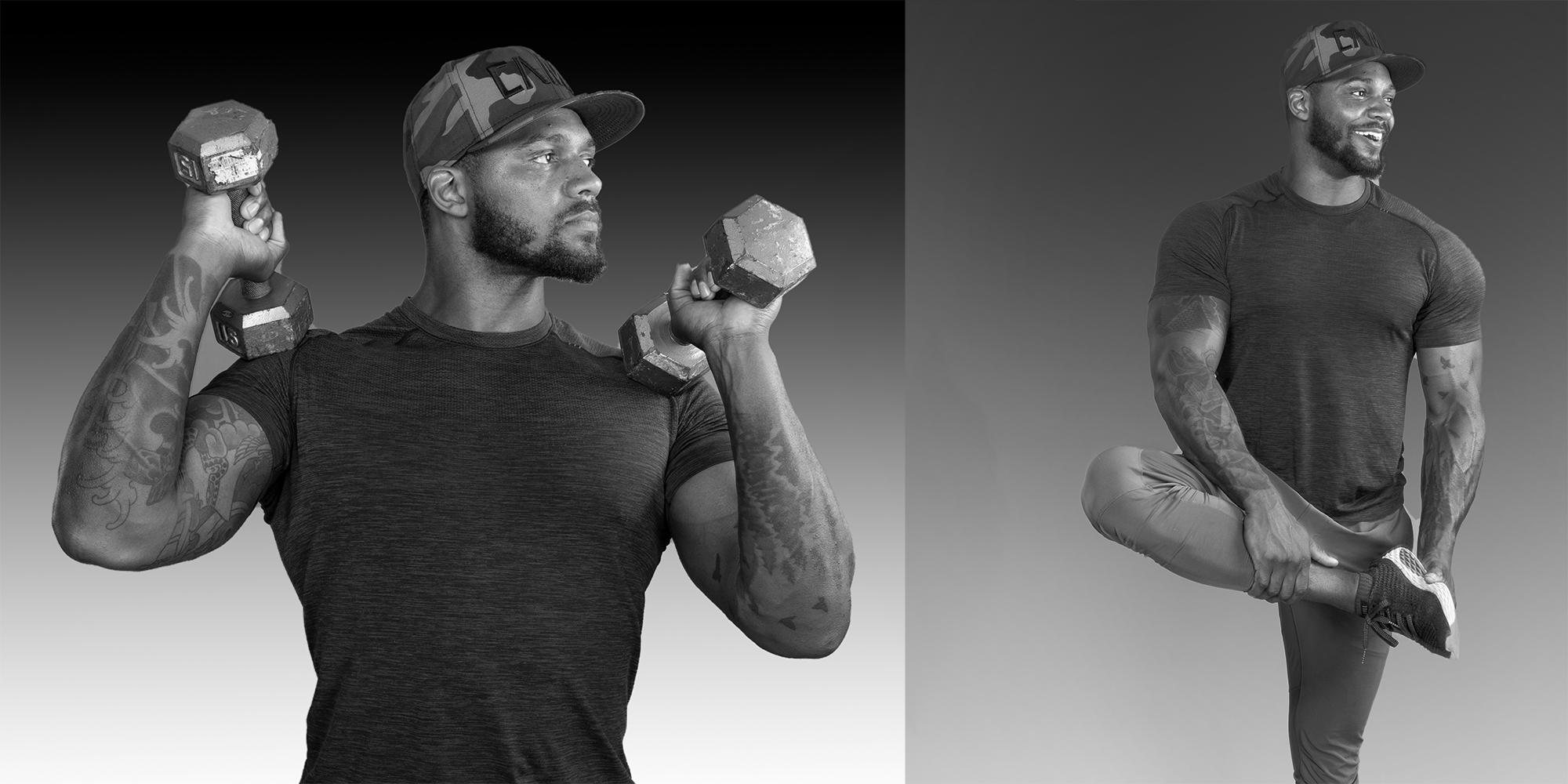
REGGIE HARVEY
Personal Trainer
CAMP Tampa
“Think healthy thoughts. Health is not just food; health is life. When you wake up, always make your bed. Do not skip breakfast. It will kick start your metabolism. Dedicate at least one hour a day to activity — a workout, a walk, a run. Get up and get active! The hardest part of working out is getting to the gym. Once you’re there, just start moving! Health is important, but a balanced lifestyle is everything.”
Tell me a bit about your background in fitness/training. How did you get into the field?
My father was a colonel in the Army, and my mother was a lieutenant colonel in the Army. Though they were not heavily involved in sports themselves, they understood and hammered into all four of their children the great importance of playing sports and staying active. We didn’t realize what they were doing at the time, but it was the little things — 10 push-ups if we left the lights on or not staring at the TV all day and going outside to run around. They also explained to us the leadership qualities and social importance of sports. That being said, growing up I played on two soccer teams during the fall season, winter indoor soccer and basketball, baseball and soccer in the spring.
In high school I started playing lacrosse. I attended St Mary’s Ryken College Preparatory High School in Maryland and excelled at lacrosse, receiving numerous college offers and scholarships. While my mom was in Afghanistan, I turned down all my scholarships and attended Norwich University Military College of Vermont. This is where I started weight training and learning more about anatomy and the way the body works. I ended up leaving Norwich and accepted an offer to play lacrosse at Limestone College. A few years after I moved to Tampa I started one-on-one training. I was given an opportunity to do small group training at Havana Square apartments by my very first client Laura Delahaye, and this is how I started group training!
About a year later I was given an opportunity that changed my life by Jamie Lanza and Jen Azzarelli to work at CAMP Tampa where I currently train. Tgeb I started competing in body-building training with the famous Ben Pakulski and my coach Calvin Williams, attaining my IFBB pro card my first year of competing, and here I am today!
What led you to share your passion for fitness with others?
At CAMP, our goal is to bring the community together in every way shape and form. It’s everything to us. About a year after I started training and posting my workout online, I received an email from a friend in Iraq struggling with staying motivated. He vented about his day-to-day struggle and that one of the things keeping him motivated and on track were my Instagram videos. That email was eye-opening to me. I soon realized that we as trainers, especially at CAMP, do so much more than just tell people what to do in the gym. We as trainers are psychologists, therapists, counselors, life coaches, friends and family. We are [about] so much more than fitness and help with so much more than fitness! CAMP is community, family, fun and love. My/our goal is to bring all of these things together in the best way possible.
What is the first thing you tell people who want to start a fitness or exercise journey?
Do not overwhelm yourself with the end result whatever it may be. Write down your goals, internalize them and then put them aside. Come up with a plan, then take things one step at a time. Wake up and take a big breath.
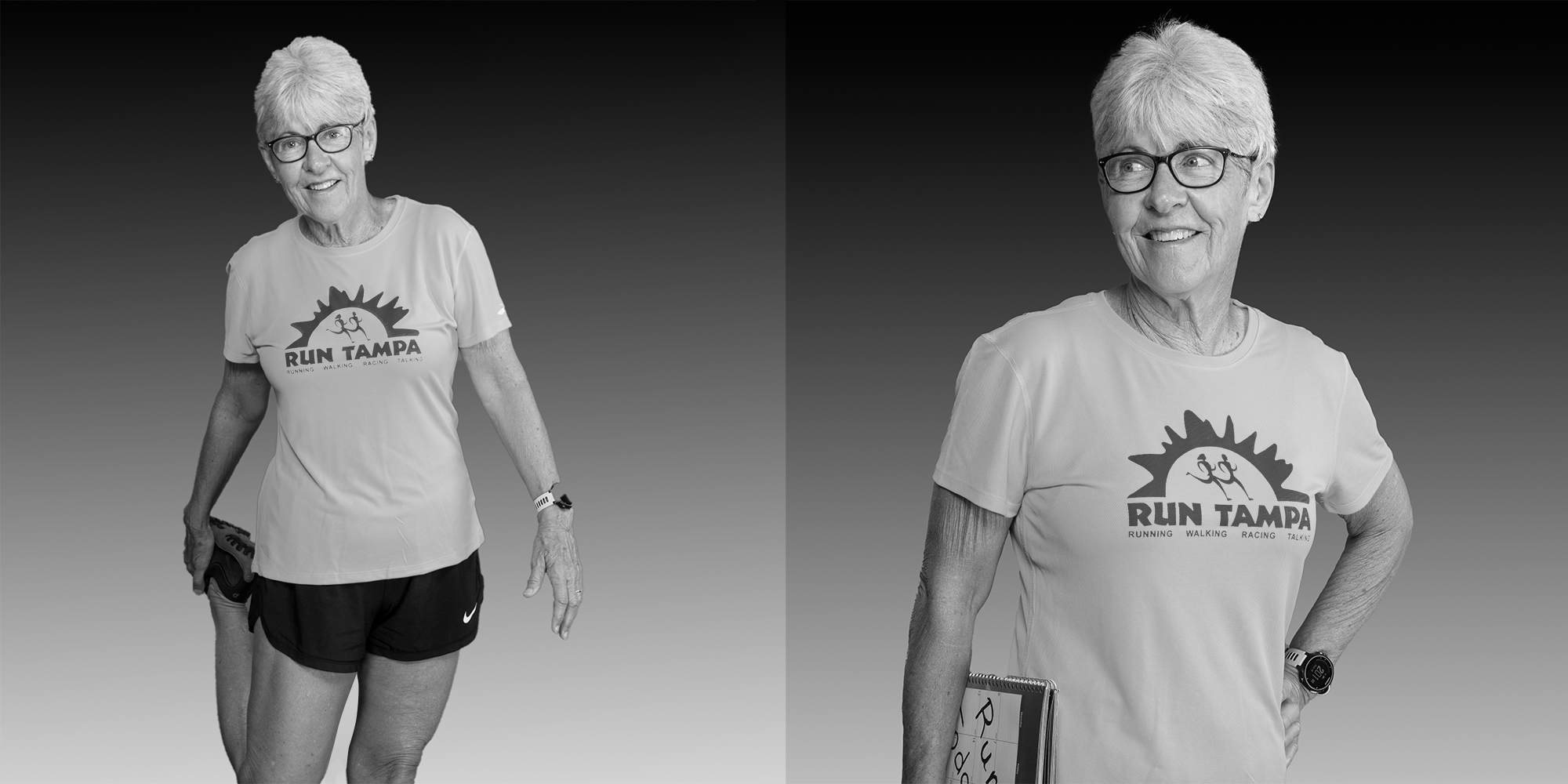
DEBBIE VOILES
Running Coach | Podcaster | Author
Founder/Director, Run Tampa | Producer/Star, The Human Race documentary
“Any amount of exercise is worth doing. A one-mile run or walk, twice a day, is still 730 miles a year. People feel like if they don’t have time to run several miles, it’s not worth doing, but running even one mile a day would make a huge difference compared to nothing. In the case of an experienced runner, that person may just think one or two miles is not going to matter, but those miles add up over the years. Moving is always the healthy option, no matter how short the window of time.”
How did you pick up running, and what led you to share your passion with others?
I was struggling to lose 10 pounds after my daughter was born, 44 years ago; she’s been running with me for the last 20. I started coaching when I realized most people didn’t understand the basic training principles that would make their running more enjoyable, improve their performance and prevent most injuries.
What is the first thing you tell people who would like to start a running practice?
Start at the right point for their current level of fitness and then progress gradually. Most people try to do too much too soon. As a result, they don’t enjoy it, and they usually end up injured. The more gradually they progress, the more likely they will become a lifelong runner, and that’s what really matters.


